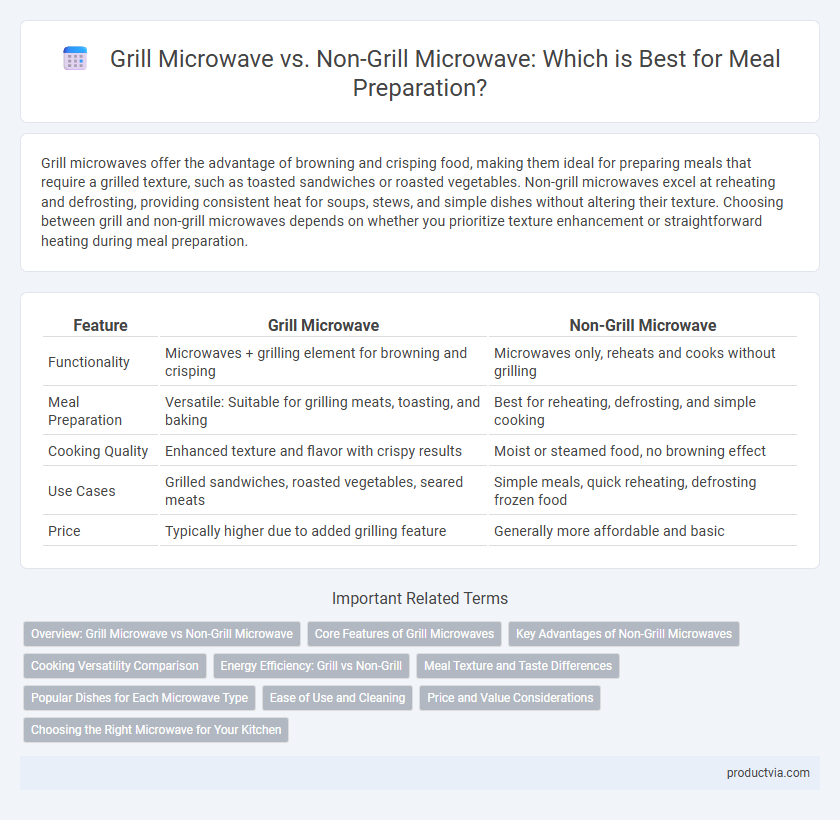Grill microwaves offer the advantage of browning and crisping food, making them ideal for preparing meals that require a grilled texture, such as toasted sandwiches or roasted vegetables. Non-grill microwaves excel at reheating and defrosting, providing consistent heat for soups, stews, and simple dishes without altering their texture. Choosing between grill and non-grill microwaves depends on whether you prioritize texture enhancement or straightforward heating during meal preparation.
Table of Comparison
| Feature | Grill Microwave | Non-Grill Microwave |
|---|---|---|
| Functionality | Microwaves + grilling element for browning and crisping | Microwaves only, reheats and cooks without grilling |
| Meal Preparation | Versatile: Suitable for grilling meats, toasting, and baking | Best for reheating, defrosting, and simple cooking |
| Cooking Quality | Enhanced texture and flavor with crispy results | Moist or steamed food, no browning effect |
| Use Cases | Grilled sandwiches, roasted vegetables, seared meats | Simple meals, quick reheating, defrosting frozen food |
| Price | Typically higher due to added grilling feature | Generally more affordable and basic |
Overview: Grill Microwave vs Non-Grill Microwave
Grill microwaves combine traditional microwave cooking with grilling capabilities, enabling browning and crisping of foods for enhanced texture and flavor, making them ideal for versatile meal preparation. Non-grill microwaves primarily focus on reheating, defrosting, and standard cooking tasks without the ability to grill, which can limit options for dishes requiring a crispy or grilled finish. Choosing between grill and non-grill microwaves depends on cooking preferences and the desired range of meal preparation techniques.
Core Features of Grill Microwaves
Grill microwaves integrate a heating element and a fan to provide browning and crisping capabilities, enhancing meal texture beyond standard microwave cooking. They offer versatile cooking modes including grilling, microwaving, and combination settings that speed up meal preparation while delivering grilled flavors. Core features such as adjustable grill racks, convection options, and multi-stage cooking programs enable precise control over cooking processes and improved culinary results compared to non-grill microwaves.
Key Advantages of Non-Grill Microwaves
Non-grill microwaves excel in quick reheating and defrosting tasks, providing uniform heating without the need for additional grilling elements. Their simpler design often results in more affordable prices and lower energy consumption, making them ideal for basic meal preparation. These microwaves are perfect for users who prioritize convenience and efficiency over advanced cooking features.
Cooking Versatility Comparison
Grill microwaves offer enhanced cooking versatility by combining traditional microwave heating with grilling capabilities, allowing for browning, crisping, and toasting in addition to standard reheating and cooking. Non-grill microwaves primarily focus on rapid heating and defrosting, limiting their functionality to simpler meal preparation tasks without the ability to achieve grilled textures or flavors. For users seeking diverse cooking methods and improved meal quality, grill microwaves provide a more flexible and comprehensive kitchen appliance.
Energy Efficiency: Grill vs Non-Grill
Grill microwaves typically consume more energy than non-grill models due to the additional heating element required for grilling functions. Non-grill microwaves focus solely on microwave radiation, making them more energy-efficient for basic reheating and cooking tasks. Choosing a non-grill microwave can reduce electricity consumption, especially when grilling is not a frequent cooking method.
Meal Texture and Taste Differences
Grill microwaves enhance meal texture by creating a crispy, browned exterior, replicating traditional grilling effects that improve flavor depth and visual appeal. Non-grill microwaves primarily use convection or microwave heating, resulting in softer textures and less pronounced taste contrasts due to the absence of direct browning. Choosing a grill microwave benefits those seeking meals with varied textures and richer, intensified flavors, while non-grill models suit quick reheating and simple cooking tasks.
Popular Dishes for Each Microwave Type
Grill microwaves excel at preparing dishes that require crisping and browning, such as grilled sandwiches, baked potatoes, and roasted vegetables, delivering a texture similar to traditional ovens. Non-grill microwaves are ideal for reheating soups, steaming vegetables, and cooking simple meals like rice and pasta, focusing on speed and convenience rather than texture enhancement. Choosing between grill and non-grill microwaves depends on whether the primary need is for quick heating or achieving grilled finishes in home-cooked meals.
Ease of Use and Cleaning
Grill microwaves offer versatile cooking options with a built-in grill function, allowing users to easily prepare crispy meals and reheat food evenly using combined microwave and grilling modes. Non-grill microwaves are simpler in design, often featuring straightforward settings that make operation intuitive, but they lack the ability to brown or crisp food, limiting meal variety. Cleaning grill microwaves can be more involved due to grill elements and additional components, whereas non-grill microwaves typically require less maintenance, making them quicker and easier to clean.
Price and Value Considerations
Grill microwaves typically cost 20-40% more than non-grill models, but they add versatility by allowing grilling and browning, enhancing meal preparation options. Non-grill microwaves are affordable and efficient for reheating and basic cooking tasks but lack the ability to achieve crispy textures and browned finishes. Consumers should weigh the added functionality and improved cooking results of grill microwaves against their higher price to determine the best value for their culinary needs.
Choosing the Right Microwave for Your Kitchen
Grill microwaves combine traditional microwave heating with grilling elements, allowing for versatile meal preparation such as browning, crisping, and reheating, which is ideal for roasting meats and toasting bread. Non-grill microwaves primarily focus on reheating and defrosting, offering simplicity and energy efficiency but lacking the ability to create textures achieved by grilling. Choosing the right microwave depends on cooking habits, kitchen space, and the desire for multifunctional appliances that enhance meal variety and presentation.
Grill Microwave vs Non-Grill Microwave for Meal Preparation Infographic

 productvia.com
productvia.com